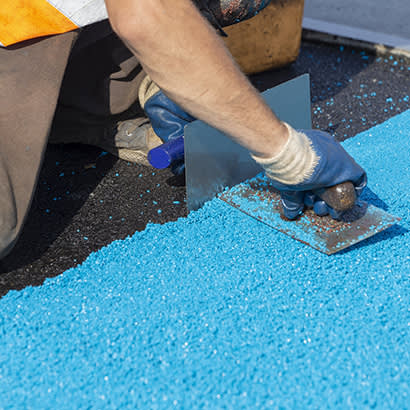
For an enhanced digital experience, read this story in the ezine.
Selecting an effective playground surface is the first step toward creating a safe and accessible playground. Playground surfacing can be split into two categories: loose fill and unitary. In this article, we’ll compare the various options within each category to help you make an informed decision for your specific playground.
Loose-Fill Surfacing
Loose-fill surfacing is often the more affordable choice, easier to install and best for drainage. Perhaps the best feature of loose fill is that it’s exceptional at absorbing impact and protecting children from serious injury after a fall. While loose-fill surfacing makes installation easy, it’s also more demanding to maintain; material can be displaced. You’ll have to regularly rake material back into the playground and refill material to maintain its safety benefits. Loose-fill options include:
Pea Gravel – Pea gravel’s major benefits include being inexpensive, easy to drain and completely unappealing to insects. However, it is difficult for children who use mobility devices to maneuver across. It’s recommended that pea gravel be used for playgrounds targeting older children, as smaller children may attempt to eat the gravel. Pea gravel requires a lot of maintenance and supervision.
Sand – Sand is inexpensive and easy to install. It is also a much softer cushioning material than pea gravel and kids are less likely to eat it. The major drawback of sand, however, is that it is very easy for objects to be buried and become a hidden hazard. Sand also has a tendency to stick onto kids and is thus taken out of the playground, so it needs to be regularly maintained. Sand isn’t very maneuverable for people in wheelchairs.
Engineered Wood Fiber – Engineered wood fiber (EWF) has proven to be the safest for playgrounds on a budget. EWF “knits” together to become more compact, therefore, providing a smoother surface that makes it easier for kids using wheelchairs to maneuver on and provides impact absorption. This compact “knit” also means that the material will stay in place better than pea gravel or sand. When it comes to maintenance, you’ll still need to monitor frequently used areas to ensure the surfacing is refilled as necessary.
Unitary Surfacing
Unitary surfacing is bound elements formed into tiles or rolled products, such as turf. These surfaces are typically made up of nylon, synthetic material or recycled rubber tires. As a result, unitary surfacing does not require a lot of maintenance and comes in a variety of colors. The downside, however, is that these surfaces are typically pricier, require professional installation and get very hot during the summer. Unitary options include:
Pour-in-Place Rubber – Pour-in-place rubber (PIP) is perhaps the most common form of unitary surfacing. The material consists of a wear layer of rubber particles and a top finish layer of granular particles that provides a smooth surface, which is ideal for children in wheelchairs. PIP is long-lasting with proper maintenance involving sealer/conditioner. However, the materials and installation, as well as repairs or replacement, can be costly.
Rubber Tiles – These interlocking 2-by-2-foot rubber squares are more expensive than loose-fill options and require professional installation, but are a bit more cost effective than PIP. Maintenance includes frequent sweeping/cleaning to reduce dirt and grime buildup in tile cracks.
Synthetic Turf – For a more natural appearance but the same shock absorption other surfacing materials provide, synthetic turf is the ideal compromise. Turf is wheelchair accessible while also being easy to maintain. A downside unique to the synthetic turf is that static electricity can build up within the material and might require an anti-static treatment to prevent electric shocks.
Given the number of playground surfacing options, it’s important to ensure that whichever option you choose, it is safe and accessible for your community members while fitting within your budget.
Joel Owen is Vice President of Sales for Discount Playground Supply.

